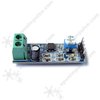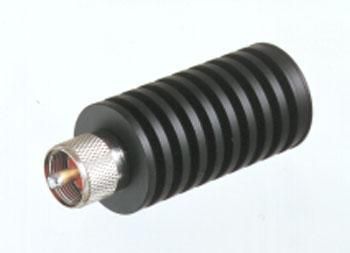If you get time - you can always look up what Texas Instruments have done...
http://www.ti.com/lit/ug/tidu765/tidu765.pdf
And I have used similar techniques in the past.
The one thing that let's me down about TI's design, is the lack of "shielding" and biasing needs in RF presence.
The link is to a PDF that has some simple circuits, a good basic explanation and a how to to fabricate a PC board to make their circuit and I've attached a PDF I got from there. But what it is lacking is what many Amateur radio ops use now for supplying power in such a circuit.
The TI design - is for single ended power supplies. A dropping resistor is used to limit current thru the FET but what they don't show you is the power needs in an environment that's going to have RF in it.
So you'll need to use some different means to power it but they are pretty much the same for a reason - RF shielding and keeping it from squealing...

To keep RF out you need a power flowing thru a simple circuit to remove stray RF from getting into the Mic. When you apply a "static" voltage - the result is the part can get damaged and or RF can get thru and cause a feedback loop. To keep voltages from your source being too high, use a divider with values that provide enough current to power the device AND provide LINEAR operation thru an Impedance Resistor.
The FET in the mic itself - if left to itself - will act a lot like a switch that turns on and off very quickly as that membrane vibrates - RI (Impedance Resistor) provides a working resistive element along with CF - a means to SLOW DOWN that rapid switching and provide a linear analog signal using a smoothing filter (low pass)..
So keep it simple but the tonal part? CF and CTF do that. But remember too, for the RI value PULLS power from the divider as that FET switches from High-Impedance State to Low-Impedance State and back again - like a switch - as your voice vibrates that membrane. So the LINEARITY of your Audio - as well as level of power and the peak tonal response curve factors into your choices of values.
Higher CF values improves tonal bandpass and raises Bass response.
Lower-smaller CF values RAISES the tone and NARROWS the bandpass.
Both CF an RI work as a filter too. CF provides smoothing of the rapid switching in regards to RI. While RI provides the working impedance against the switching effect the FET imposes on the circuit and overall volume as a linear function of the smoothing effect CF and RI have on each other.
IF RI is too low, distortion and weak audio occurs, for RI "dumps" charge too rapidly thru CF and the Mic itself...
If RI is too high, weak audio and lack of fidelity - tinny response (RC circuit Hi - Pass tonal filter).
Just remember that many good mics and radios never lasted long when people used Electrets and forgot to accommodate for RF as well as voltage potentials - both can ruin the FET-amp inside the element.
http://www.ti.com/lit/ug/tidu765/tidu765.pdf
And I have used similar techniques in the past.
The one thing that let's me down about TI's design, is the lack of "shielding" and biasing needs in RF presence.
The link is to a PDF that has some simple circuits, a good basic explanation and a how to to fabricate a PC board to make their circuit and I've attached a PDF I got from there. But what it is lacking is what many Amateur radio ops use now for supplying power in such a circuit.
The TI design - is for single ended power supplies. A dropping resistor is used to limit current thru the FET but what they don't show you is the power needs in an environment that's going to have RF in it.
So you'll need to use some different means to power it but they are pretty much the same for a reason - RF shielding and keeping it from squealing...
To keep RF out you need a power flowing thru a simple circuit to remove stray RF from getting into the Mic. When you apply a "static" voltage - the result is the part can get damaged and or RF can get thru and cause a feedback loop. To keep voltages from your source being too high, use a divider with values that provide enough current to power the device AND provide LINEAR operation thru an Impedance Resistor.
The FET in the mic itself - if left to itself - will act a lot like a switch that turns on and off very quickly as that membrane vibrates - RI (Impedance Resistor) provides a working resistive element along with CF - a means to SLOW DOWN that rapid switching and provide a linear analog signal using a smoothing filter (low pass)..
So keep it simple but the tonal part? CF and CTF do that. But remember too, for the RI value PULLS power from the divider as that FET switches from High-Impedance State to Low-Impedance State and back again - like a switch - as your voice vibrates that membrane. So the LINEARITY of your Audio - as well as level of power and the peak tonal response curve factors into your choices of values.
Higher CF values improves tonal bandpass and raises Bass response.
Lower-smaller CF values RAISES the tone and NARROWS the bandpass.
Both CF an RI work as a filter too. CF provides smoothing of the rapid switching in regards to RI. While RI provides the working impedance against the switching effect the FET imposes on the circuit and overall volume as a linear function of the smoothing effect CF and RI have on each other.
IF RI is too low, distortion and weak audio occurs, for RI "dumps" charge too rapidly thru CF and the Mic itself...
If RI is too high, weak audio and lack of fidelity - tinny response (RC circuit Hi - Pass tonal filter).
Just remember that many good mics and radios never lasted long when people used Electrets and forgot to accommodate for RF as well as voltage potentials - both can ruin the FET-amp inside the element.
Attachments
Last edited:






